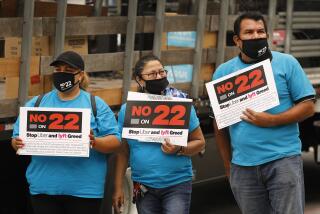Op-Ed: A common-sense solution to the Uber vs. taxi wars
Since Uberâs launch in San Francisco five years ago, government officials have wrestled with how to address this new type of transportation service. Meanwhile, taxi drivers have cried foul over the unequal regulatory environment. They face a mountain of rules, ranging from sensible to comical and even bizarre, while ride-share upstarts Uber and Lyft operate outside most taxi laws. Policymakers across the nation could learn from their peers in Florida, who may have found a way to level the playing field and still make way for innovation.
Most rules ... are unnecessary in a world in which cellphone apps offer both drivers and riders instant feedback on the otherâs behavior and reputation.
Last month, Broward County commissioners voted to reduce excessive taxi and ride-sharing regulations, creating a single set of simple rules that apply equally to all transportation services. Days later, Collier County joined the cities of Sarasota and Gainesville in completely deregulating vehicle-for-hire services, putting taxis and ride-share companies on equal footing. Now others â including Miami-Dade County, Portland, Ore., and Cambridge, Mass. â are considering similar changes.
What kinds of laws do traditional taxi drivers face? Here are some examples:
Most cities set a dress code for drivers; many explicitly prohibit bathing suits. Los Angeles keeps it classy by specifying black dress pants, black dress shoes and socks, and a white dress shirt. Female drivers have the option of wearing a black skirt.
In Miami, itâs illegal to operate a taxi without hubcaps, but again, Los Angeles does this one better by requiring that all the hubcaps match. Los Angeles also stipulates the proper lettering for signs in the taxicab. Apparently someone on L.A.âs Board of Taxicab Commissioners has a problem with serif fonts.
Some cities appear to regard taxi drivers as not-so-distant cousins of Neanderthals, restricting a driver to only the words âtaxiâ or âcab,â or if they are feeling particularly verbose, âtaxicab,â when soliciting a passenger. But monosyllabic solicitation must also be civilized: The L.A. taxi code prohibits using a âloud or boisterous tone of voice.â
Cities even micromanage taxi paint jobs. Washingtonâs City Council decided in 2012 that the cabs werenât colorful enough and put the Taxicab Commission in charge of coming up with a unified paint scheme. However, the paint schemes submitted were so stunningly terrible â one looked like the Brazilian flag â that council members immediately considered revising the legislation to require a new design. The final result probably wonât please University of Michigan fans, though; scarlet and gray are Buckeye colors. Less amusing, taxi owners will have to pay about $500 a vehicle to comply with the law.
Weâve singled out some of the more arcane regulations. Most rules, however, are unnecessary in a world in which cellphone apps offer both drivers and riders instant feedback on the otherâs behavior and reputation. The only valid reason to regulate the transportation service industry is to ensure public safety. But burdensome regulations do more harm than good by creating barriers to entry, which reduce competition.
For example, a seemingly innocuous rule such as the one mandating unified paint schemes makes it difficult for taxi companies to compete via product differentiation. This prevents riders from easily distinguishing taxis with a reputation for safety and high quality from riskier, low-quality fleets. Companies, in turn, have little incentive to hire better drivers or use cabs with better safety features.
Other common taxi regulations are more obviously anticompetitive. Many cities limit the total number of taxi licenses available, and some even mandate a minimum number of cabs per company, crowding out newcomers. Still others impose steep licensing fees, outlaw price competition or require an additional license to pick up airport passengers.
Economists have long argued that stiff competition is often far better than detailed regulations when it comes to fostering safety and quality. Recent research by the Mercatus Center at George Mason University illustrates how new communication technologies used by Uber and Lyft, which allow drivers and riders to rate each other, can fill the information gap between rider and driver.
Itâs likely that the simple-yet-powerful discipline instilled by genuine competition and easily accessible customer reviews would outmatch even New Yorkâs 350-page taxi manual.
In many municipalities, the taxi lobby has convinced policymakers that there are only two solutions: Either level the playing field by forcing ride-sharing firms to obey excessive taxi regulations, or ban ride-sharing completely. Leaders in Florida have shown that thereâs another option: Embrace progress by removing needless rules for all transportation service companies.
Matthew Mitchell is a senior research fellow and director of the Project for the Study of American Capitalism with the Mercatus Center at George Mason University, where he is an adjunct professor of economics. Michael Farren is a research fellow with the Project for the Study of American Capitalism.
Follow the Opinion section on Twitter @latimesopinion and Facebook
More to Read
A cure for the common opinion
Get thought-provoking perspectives with our weekly newsletter.
You may occasionally receive promotional content from the Los Angeles Times.










